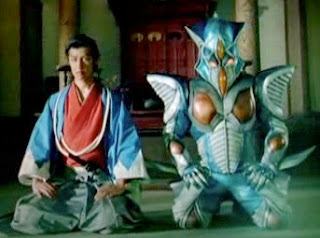 |
| DIS "Light and Shadows" |
"We're always in a fight for the future." - Captain Christopher Pike
The Randomizer brings me to
Discovery for the first time, and against all odds, the first appearance of Spock in this rewatch comes when the half-human, half-Vulcan icon is played by Ethan Peck. This episode's setup, and indeed that of the first half of the season, is another Search for Spock. Foster sister and series lead Michael Burnham finally finds him in this episode, as an addled Spock is fought over by his parents, Starfleet, and Section 31. This half of the installment isn't as compelling to me as the other half, which is one of those science-heavy SF scenarios that
Discovery is accustomed to churning out at this point.
It revolves around a massive time distortion field generated by multiple time rifts, and as Ensign Sylvia Tilly points out, it's cool to put "time" in front of most anything. What differentiates
Discovery technobabble from, say,
Voyager technobabble is that in the more contemporary show, the problem-solving feels, well, more contemporary. Characters tend to discuss brain-expanding crises like a modern think tank would, with an emphasis on slightly more relatable concepts and soundbites. As Paul Stamets says, "Trust the math".
This story involves Captain Pike (played with easygoing authority and quiet charisma by Anson Mount) and Section 31 Specialist Ash Tyler piloting a shuttle into the temporal anomaly. The probe Discovery had sent in has uncannily technologically evolved for 500 years, now a timorous beastie resembling a mix between those squid robots from
The Matrix and a Doctor Octopus product. This is a breezily trippy SF concept that the episode efficiently gets some thrills from, and on a micro level it also recalls the V'Ger space probe's evolution in
Star Trek: The Motion Picture.
Shifting gears back to the Burnham/Spock story, it tends to inelegantly lurch around in this episode. There's a whole to-do about getting Spock to Section 31 custody only for Burnham to break him out a few minutes later. It's very busy storytelling, and quite opaque on top of that. On the plus side, it leads to a fun fight out of nowhere between Burnham and Mirror Georgiou.
And then Burnham deciphers the meaning of the numbers the raving Spock has been repeating: coordinates for Talos 4. This is a bit of a punch-the-air moment for big Star Trek fans, as that's the planet from the first Trek episode ever made, "The Cage". It represents where it all began.
Stray observations:
- The time distortion field is described as a four-dimensional problem, and we just came from a two-dimensional problem last time on the Randomizer, in TNG's "The Loss".
- At one point we see an exterior view of the turbolift system on Discovery. It's like seeing the superstructure of an indoor roller coaster.
A solid Discovery plot is paired with a Burnham/Spock story I'm not a huge fan of in this particular installment. I would rate the former a 7 and the latter a 5 so let's average out at
6/10.




















